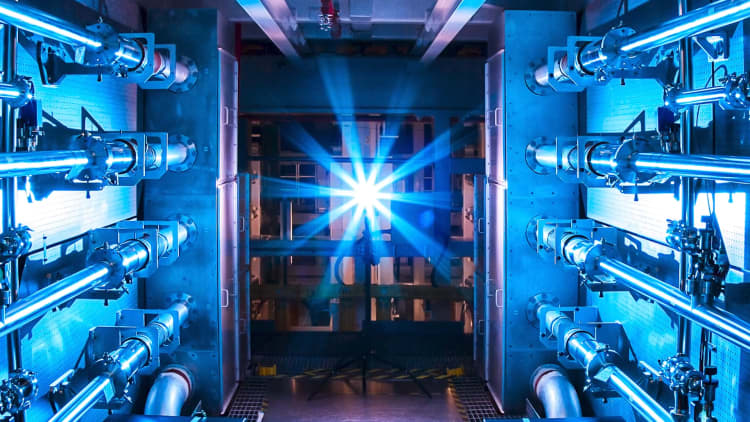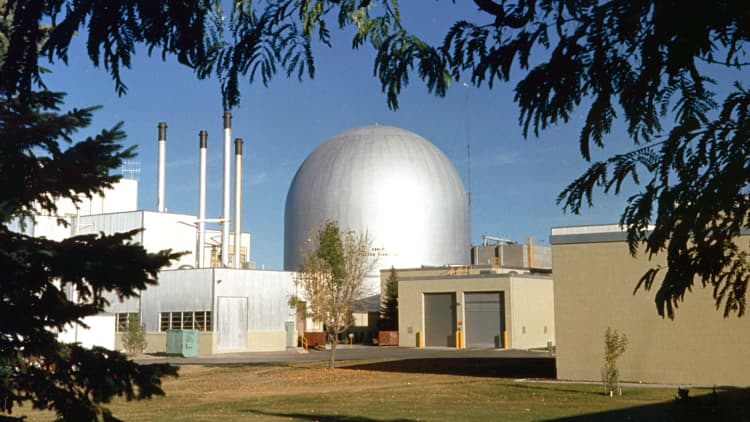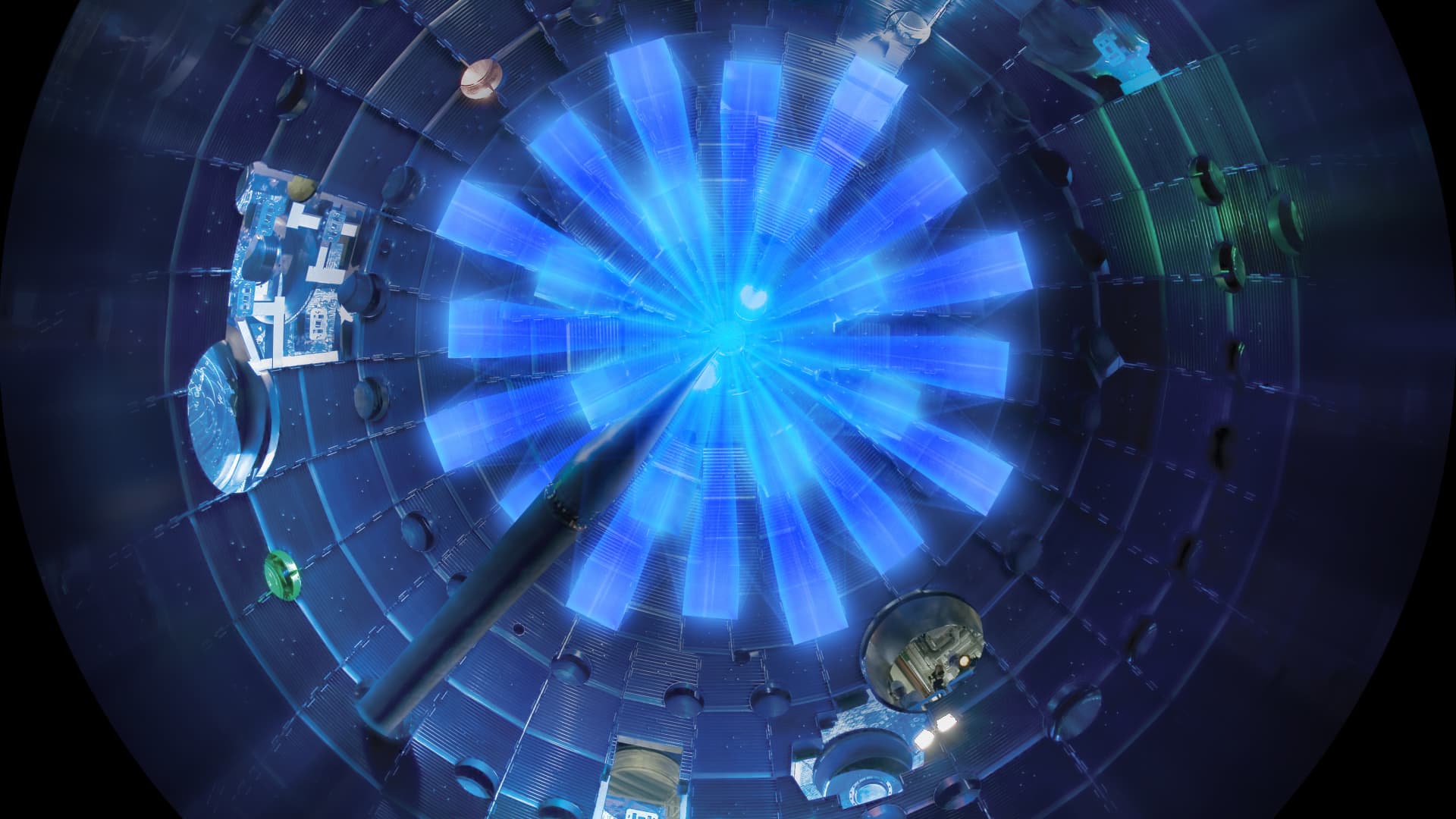
The nuclear fusion breakthrough heralded on Tuesday was a historic event, culminating decades of research.
At the same time, fusion power will not be contributing electricity to any power grid for at least a decade, according to most industry watchers. To get there, there will have to be many more technical breakthroughs beyond what was celebrated on Tuesday — and the money to fund them.
Just after 1 a.m. on Monday, Dec. 5, researchers at the Lawrence Livermore National Laboratory in California executed a successful experiment to produce more energy from a nuclear fusion reaction than went into the lasers used to power the reaction.
“We got out 3.15 megajoules, we put in 2.05 megajoules in the laser,” said Mark Herrmann, a program director at Lawrence Livermore, on Tuesday. “That’s never been done before in any fusion laboratory anywhere in the world. So it’s super exciting.”
In a technical panel discussion after the main press announcement on Tuesday, scientists on the team recounted their reactions on learning the news.
Tammy Ma, a laser-plasma physicist at the lab, was waiting in an airport when her boss called her. “I burst into tears. I was jumping up and down in the waiting area, the crazy person.”
It took about 300 megajoules of energy from the electricity grid to fire the laser that was used in the experiment, said Herrmann on Tuesday. That’s equivalent to what is included in about two-and-a-half gallons of gasoline.
All of that energy went into the laser fusion reaction that showed net gain of about 1.1 megajoules — enough energy to boil a teakettle maybe two or three times.
“This is a science achievement, not a practical one,” Omar A. Hurricane, a chief scientist at Lawrence Livermore, told CNBC.
But the amount of energy isn’t the point. “The laser wasn’t designed to be efficient. The laser was designed to give us as much juice as possible to make this incredible conditions possible,” Herrmann said. “So there are many, many steps that would have to be made in order to get to an inertial fusion as an energy source.”
That’s partly because National Ignition Facility, where the demonstration took place, is 20 years old, and was constructed using technological components made in the 1980s and 1990s. Laser technology has progressed significantly since then.
The reason for the celebration was simply that energy was created at all.
“It’s exciting because it proves that fusion can work, and it opens the floodgates to further interest, investment, and innovation toward turning fusion into a power source,” said Arthur Turrell, a plasma physicist and the author of The Star Builders.
(L-R) US Under Secretary of Energy for Nuclear Security, Jill Hruby; US Energy Secretary, Jennifer Granholm; Director of the Lawrence Livermore National Laboratory, Kimberly Budil; White House Office of Science and Technology Policy Director, Arati Prabhakar; and National Nuclear Security Administration Deputy Administrator for Defense Programs, Marvin Adams hold a press conference to announce a major milestone in nuclear fusion research, at the US Department of Energy in Washington, DC on December 13, 2022. Researchers have achieved a breakthrough regarding nuclear fusion, a technology seen as a possible revolutionary alternative power source.
Olivier Douliery | Afp | Getty Images
The industry will need a whole lot more firsts
Progress is happening fast, but the scope of the problem is immense.
A little more than a year ago, in August 2021, the same laboratory had another breakthrough that Hurricane billed as “a Wright Brothers moment.” That experiment achieved fusion ignition in a controlled environment for the first time, but the total energy that was put into the reaction was less than what came out.
“A plasma is said to ignite when the energy gain due to fusion reactions exceeds all energy losses, resulting in a rapid escalation of temperature, pressure, and fusion energy yield. Previously this had only been achieved in the detonation of nuclear weapons,” explained Pravesh Patel, the scientific director of the fusion startup Focused Energy and a former scientist at Lawrence Livermore.
In that 2021 experiment, the energy gain was 0.73. The Dec. 5 experiment was the first time an energy gain over 1.0 was achieved — specifically, an energy gain of 1.5.
“Getting anything above 1x is everything psychologically because it shows fusion can be a (net) source of energy!” Turrell told CNBC. “To put it another way, it is this moment when >1x is achieved that will make it into the history books.”
An artists’ rendering of the 192 laser beams shooting to the center of the target chamber at the National Ignition Facility.
Courtesy Damien Jemison at the Lawrence Livermore National Laboratory
Patel expects to see energy gain of 4 or 5 coming out of the team at Lawrence Livermore eventually. But to make commercial fusion with lasers will require an energy gain of approximately 100x, Patel said.
To get to that level will require new facilities and new technology developments of component parts, such as efficient diode-pumped lasers.
“That will need progress in so-called ‘advanced concepts’ such as fast ignition or shock ignition, that are designed for high gain. Those concepts require new facilities to be built, so a breakthrough there will take until later this decade,” Patel said.
Moritz von der Linden, CEO of startup Marvel Fusion, also emphasized the importance of new lasers.
“Newest generation laser systems at other or new facilities must show that they can easily fire 10 laser pulses per second with high energies. Also, the targets must have an efficient energy absorption rate and be mass producible,” Linden told CNBC in a statement. “Only with optimized targets and latest-generation laser systems is it possible to show a net energy gain — the next truly revolutionary milestone. That will be one of the toughest engineering challenges imaginable to mankind.”
Here, the preamplifier module increases the laser energy as it heads toward the target chamber at the National Ignition Facitility.
Photo courtesy Damien Jemison at Lawrence Livermore National Laboratory
Funding will have to increase dramatically
While it will be more than a decade until fusion is commercialized, investors are already pouring money into the sector: The private fusion industry has seen almost $5 billion in investment, according to the industry trade group, the Fusion Industry Association, and more than half of that has been since since the second quarter of 2021.
Most of that investment gone toward a different approach called magnetic fusion, which uses a donut-shaped device called a tokamak. Only about $180 million has gone into inertial fusion, the approach that typically uses lasers, according to Fusion Industry Association CEO Andrew Holland.
Regardless of the approach, Tuesday’s announcement is significant for the industry as a whole, according to Dennis Whyte, who works at MIT and cofounded Commonwealth Fusion Systems (CFS), a leading startup working with tokamak-based fusion that’s raised more than $2 billion.
“While the technology readiness of tokamaks is higher for energy systems, the breakthrough announced yesterday was a scientific one confirming that net energy can be produced by the fusion fuels,” Whyte told CNBC. “So this is an important result for all fusion endeavors.”
In September, the Department of Energy announced $50 million will go toward private fusion companies in public-private partnerships.
That funding is a critical step for fusion to be commercial by the late 2030s, where most fusion industry watchers are aiming, Patel told CNBC, but it is not enough. There needs to be between 10 and 100 times as much investment to “meaningfully accelerate the time it will take to commercialize fusion and reduce our dependency on fossil fuels,” Patel told CNBC.
Perhaps the greatest criticism of fusion is that it will take too long to come online to be helpful in responding to climate change.
But industry participants believe that bold action can succeed in time.
“In March, the White House agreed and launched a program to work together with the private sector to shoot for a ‘pilot plant’ with a bold decadal plan,” Whyte told CNBC. “Why this timeline? Well if you work backwards from 2050, the math tells you when you need the pilot plant if you want fusion to play a role in combatting climate change, based on the scale-up times that will be required. This will be hard, but worthwhile to attempt.”






